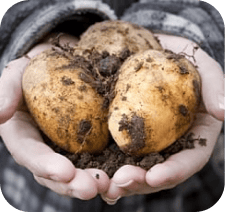Nothing causes organic gardeners more worries, and more temptation to resort to harmful sprays and other treatments, than problems with fruit trees. You might disagree — after all, the pest and disease problems we have with our plants depends on what we grow and where we grow it — but anyone that’s had to deal with blights, cankers, or caterpillars knows there’s little guidance and few cures that don’t resort to spraying something awful on the trees and bushes that produce the fruits our children will eat.
That’s why David Deardorff and Kathryn Wadsworth’ new book What’s Wrong With My Fruit Garden? 100% Organic Solutions for Berries, Trees, Nuts, Vines, and Tropicals (Workman Publishing Company) is such a valuable resource. It’s a comprehensive and well-organized guide to the problems we might encounter with fruits, nuts, and berries that offers a host of solutions to be tried for any given problem.

FREE SHIPPING!
Ladybugs
This native ladybug species is the best known garden predator available.
Learn moreBackyard trees and shrubs are important components of your landscape. With our selection of natural tree care products you can give them the attention needed for strong growth and maximum blooming, not only at planting, but for a lifetime. Got bugs? Click on our Orchard & Tree Problems page for insect descriptions and a list of earth-friendly remedies.
Most valuable is its description of various symptoms which not only helps identify the problem your tree faces but then suggests the cause and its solutions. Losing fruit early from your chestnut tree or finding the nut shells pitted or sporting curly-cue designs? Are the shoot tips of your gooseberry bushes dying off? Are the undersides of your stone fruit tree leaves playing host to masses of tiny wooly-gray insects? What’s Wrong With My Fruit Garden? offers a list of solutions as well as a host of preventive measures.
That’s one thing we admire about the book. In tried-and-true organic style, it places the emphasis on establishing and maintaining healthy plants as a way to ward off pests and disease. As every organic gardener knows, you’re much less likely to encounter problems if you provide the right conditions — soil, sunlight, temperature — to assure that your plants are their strongest and most pest-resistant. This concept is central to Integrated Pest Management strategies and the key to success in any organic growing program.
This begins when the trees are located and planted. What’s Wrong deals with this first, a big reason why we mentioned it in an earlier post on spring tree planting. The book’s first “symptom” section then identifies problems associated with temperature (freeze damage, frost cracks, leaf scorch, and the like), soil-related problems including mineral and other nutrient deficiencies, light and water-related problems, and a section on recognizing other environmental disorders such as poor pollination.
The book then goes into specific “Plant Portraits,” everything from almonds to watermelons (yes, the book deals with various vine fruits as well as bushes and trees). There are pages on the fruits you’d expect — apples, pears, and apricots — berries — currants, mulberries — citrus fruits, and some fruits you might not expect including loquat and kiwi. Have questions about pruning your olive trees? You’ll find answers here.

Then comes the largest and most useful section: the “problem-solving guides.” Broken into “symptom,” “diagnosis” (usually an insect or disease) and “solution,” the guide provides pictures to help identify the problem and page numbers referencing how each solution can be applied. These solutions range from when and how to deploy beneficial nematodes to cutting loose chickens and ducks on marauding slugs and snails.
One of the most frequently applied insect killing techniques used in conjunction with fruit trees is the spraying of horticultural oils to smother insects, mites, their eggs, and larvae. Using such oils is particularly problematic for organic gardeners because they often contain petroleum products. The authors, while pointing out that it’s often difficult to determine, recommend that organic growers use only sprays made with vegetable oils. They also give a long list of cautions when using such oils. And they give directions on making your own.
While there are plenty of good sources of information on dealing with fruit tree and berry vine problems available online, none are as detailed, as comprehensive, and as easy to use s What’s Wrong With My Fruit Garden? It’s a book we can’t recommend enough to anyone who grows their own fruits, nuts, berries, and melons.











